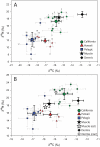Using stable isotope analysis to understand the migration and trophic ecology of northeastern Pacific white sharks (Carcharodon carcharias)
- PMID: 22355313
- PMCID: PMC3280240
- DOI: 10.1371/journal.pone.0030492
Using stable isotope analysis to understand the migration and trophic ecology of northeastern Pacific white sharks (Carcharodon carcharias)
Abstract
The white shark (Carcharodon carcharias) is a wide-ranging apex predator in the northeastern Pacific (NEP). Electronic tagging has demonstrated that white sharks exhibit a regular migratory pattern, occurring at coastal sites during the late summer, autumn and early winter and moving offshore to oceanic habitats during the remainder of the year, although the purpose of these migrations remains unclear. The purpose of this study was to use stable isotope analysis (SIA) to provide insight into the trophic ecology and migratory behaviors of white sharks in the NEP. Between 2006 and 2009, 53 white sharks were biopsied in central California to obtain dermal and muscle tissues, which were analyzed for stable isotope values of carbon (δ(13)C) and nitrogen (δ(15)N). We developed a mixing model that directly incorporates movement data and tissue incorporation (turnover) rates to better estimate the relative importance of different focal areas to white shark diet and elucidate their migratory behavior. Mixing model results for muscle showed a relatively equal dietary contribution from coastal and offshore regions, indicating that white sharks forage in both areas. However, model results indicated that sharks foraged at a higher relative rate in coastal habitats. There was a negative relationship between shark length and muscle δ(13)C and δ(15)N values, which may indicate ontogenetic changes in habitat use related to onset of maturity. The isotopic composition of dermal tissue was consistent with a more rapid incorporation rate than muscle and may represent more recent foraging. Low offshore consumption rates suggest that it is unlikely that foraging is the primary purpose of the offshore migrations. These results demonstrate how SIA can provide insight into the trophic ecology and migratory behavior of marine predators, especially when coupled with electronic tagging data.
Conflict of interest statement
Figures






References
-
- Boustany AM, Davis SF, Pyle P, Anderson SD, Le Boeuf BJ, et al. Satellite tagging - Expanded niche for white sharks. Nature. 2002;415:35–36. - PubMed
-
- Weng KC, Boustany AM, Pyle P, Anderson SD, Brown A, et al. Migration and habitat of white sharks (Carcharodon carcharias) in the eastern Pacific Ocean. Mar Biol. 2007;152:877–894.
-
- Domeier ML, Nasby-Lucas N. Migration patterns of white sharks Carcharodon carcharias tagged at Guadalupe Island, Mexico, and identification of an eastern Pacific shared offshore foraging area. Mar Ecol Prog Ser. 2008;370:221–237.
-
- Dulvy NK, Baum JK, Clarke S, Compagno LJV, Cortes E, et al. You can swim but you can't hide: the global status and conservation of oceanic pelagic sharks and rays. Aquatic Conserv Mar Freshw Ecosyst. 2008;18:459–482.
Publication types
MeSH terms
Substances
LinkOut - more resources
Full Text Sources
Miscellaneous

